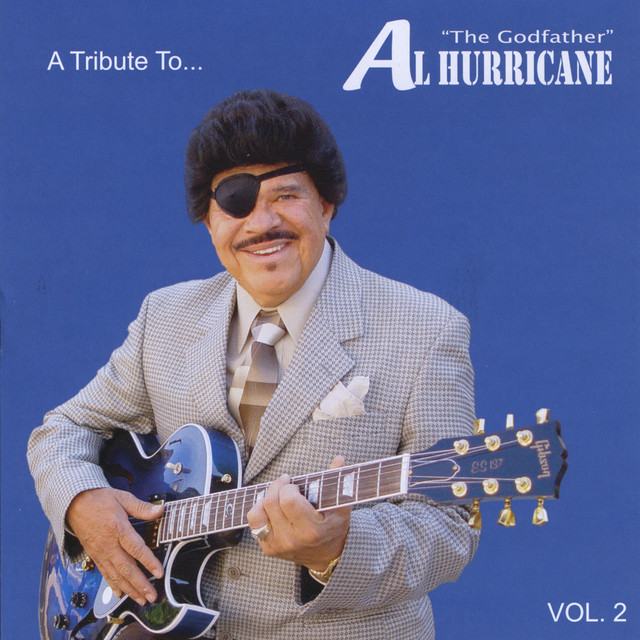Al Hurricane -- The Godfather of New Mexico music
[The Blues] [Other writing] [African Guitar CDs] [Blues CDs] [My CD and album projects] [Joseph Spence guitar DVD] [Elijah Wald bio]
 Very few people have invented a genre of music. Alberto “Al Hurricane” Sánchez, who died on Oct. 22, 2017, at age 81, was one of those few. Starting out as a one-man pre-teen mariachi, singing Mexican songs for tourists in Albuquerque’s old town, he eventually became known throughout the central Southwest as the Godfather of New Mexico Music.
Very few people have invented a genre of music. Alberto “Al Hurricane” Sánchez, who died on Oct. 22, 2017, at age 81, was one of those few. Starting out as a one-man pre-teen mariachi, singing Mexican songs for tourists in Albuquerque’s old town, he eventually became known throughout the central Southwest as the Godfather of New Mexico Music.
At first Al had no intentions of starting a new style. He was just trying to please the dance crowds in his hometown of Albuquerque, New Mexico, by playing the full range of music they liked to dance to. That meant playing the latest R&B and pop hits, and also the latest Mexican ranchera hits. He started out in the early 1950s with a band called the Sentimentalists, which evolved by the end of the decade into the Night Rockers. Al doubled on saxophone and guitar, with his brother Tiny Morrie on guitar or keyboards, and by the early 1960s they were one of the most popular bands in town.
Hurricane was in a privileged position because his mother, Bennie Sánchez, after booking a few concerts for him, built herself into the city’s most successful concert promoter, bringing in artists like Ray Charles, James Brown, and eventually Elvis Presley, as well as Mexican stars like Antonio Aguilar – and more often than not, the Night Rockers would be the backing band and opening act. That led to a couple of side projects, like the months Al toured as guitarist with Fats Domino’s band, but more importantly it meant that his band worked regularly and became adept at both the Anglo and ranchera repertoires.
At first, the Night Rockers mostly recorded instrumentals under Al’s name and English-language rock ‘n’ roll featuring his brother Tiny Morrie singing lead. But in 1965 Al released his first Spanish-language single, “La Mula Bronca,” on the family’s own Hurricane record label, and in 1968 he put out the label’s first LP, Mi Saxophone. It had Al singing all Spanish-language songs, many of his own composition, but rather than imitating Mexican ranchera styles, the backing band was a basic rock ‘n’ roll outfit, featuring his distinctive guitar work.
That style would eventually come to be known as “New Mexico music,” the favored music of the centuries-old Spanish or Hispanic natives of the northern New Mexico mountain country, and it is the most vital regional style in the United States. While far less well-known than Tejano or Cajun music, it is far more prominent in its home region, with a half-dozen radio stations playing pure New Mexico music playlists, an annual awards show, and concerts in clubs and casinos every weekend throughout the northern half of the state. Dozens of other artists helped shape the style, including the Purple Haze, Roberto Griego, and later bands like Perfección de Chimayó, and Cuarenta y Cinco—but Al Hurricane is the unchallenged founder and “Godfather” and his songs, along with those of his brothers Tiny Morrie and Baby Gaby, remain bedrock standards, played at every New Mexico music dance.
The basic New Mexico style is similar to Tejano, but Al was recording before Texas innovators like Little Joe and Sunny Osuña and his sound has some notable differences. New Mexico bands rarely use accordion, tend to feature faster tempos, and tend to have hot lead guitarists. They also pride themselves on keeping it simple, playing straight-ahead tunes for dancers rather than exploring fancy chords and arrangements.
Along with his own hits, Al is notable for having nurtured generations of New Mexico artists in his band. He always encouraged young musicians, and continued to explore new territory, branching out in recent years to record in current rhythms like reggaetón and startling some fans by adding Italian songs to his shows—his mother was half Italian, and he had grown up listening to his uncles sing Italian favorites. When I spent an afternoon with him in his home, he sang an astonishing range of music, accompanying himself on the keyboard as he segued from Red Foley to Fats Domino, to operatic Italian pop songs from his collection of Pavarotti albums.
Onstage, he tended to feature his hits, but enjoyed startling young fans by playing ferocious guitar solos, beyond anything on his albums. He cheerfully described himself as “a ham,” and his shows were designed to please everyone, with hot rock ‘n’ roll, soaring ballads, lilting waltzes, and moments when Al would come down off the stage to sing among the swirling dancers.
A few years ago I traveled all over New Mexico interviewing musicians, radio programmers, record sellers, dancers, and fans of all ages. The scene is small and competitive, and there were plenty of stories, some good and some bad, about virtually every well-known artist. But, in all that time, I never heard anyone say a bad word about Al Hurricane. He was universally beloved and respected by listeners and musicians alike. And, if he remains little known outside his home region, for those who know him he will always be one of the greats, a unique giant of American music.